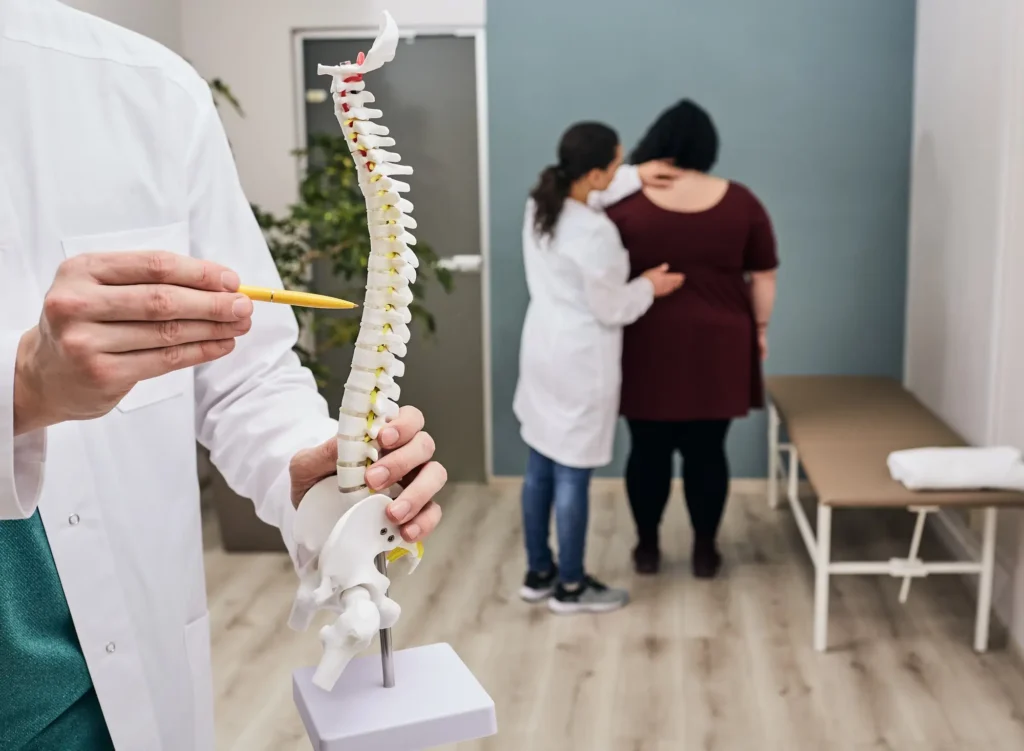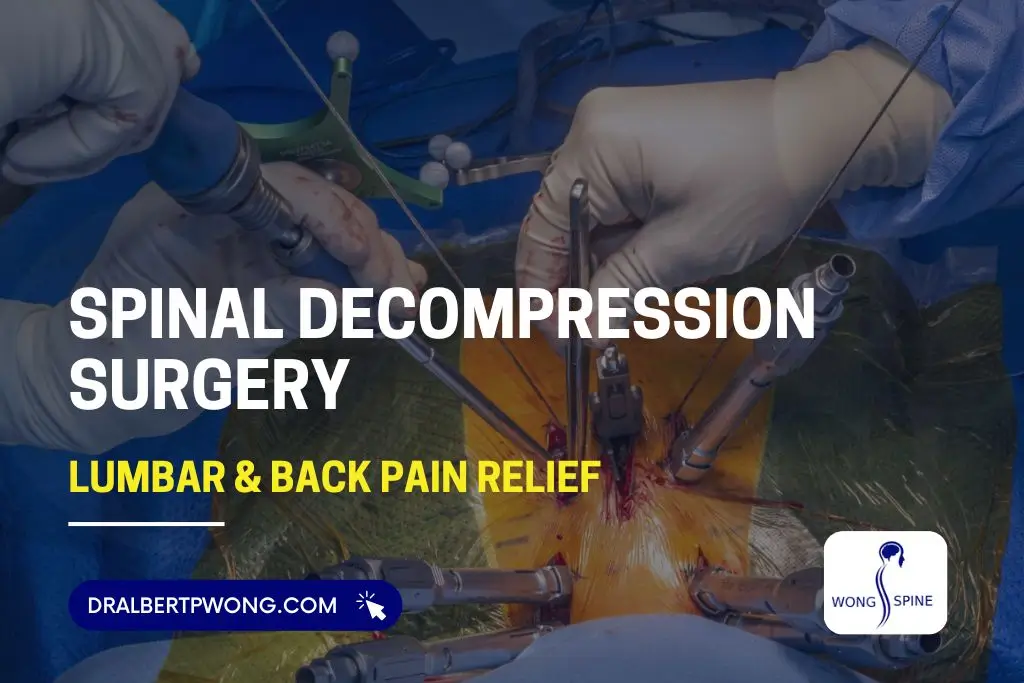Spinal fusion is a surgical procedure. It joins two or more vertebrae in the spine. The surgery helps relieve pain, correct spinal deformities, or stabilize the spine after an injury.
The procedure is usually effective. However, some patients may experience complications or discomfort afterward. Knowing the common problems can help you recognize them early and get timely medical care.
What is spinal fusion?
Spinal fusion is a surgical procedure. It permanently joins two or more vertebrae in the spine. The goal is to stabilize the spine and reduce movement between the affected vertebrae.
Surgeons use bone grafts, screws, rods, or plates to create the fusion. Limiting movement helps relieve pain and prevents further spinal damage.
Spinal fusion is commonly performed for:
- Degenerative disc disease.
- Scoliosis or other spinal deformities.
- Herniated discs.
- Spinal fractures.
- Chronic back or neck pain.
Spinal fusion is considered when non-surgical treatments do not relieve symptoms. These treatments include medication, physical therapy, or injections. The procedure is tailored to each patient’s condition and overall health.

Causes and Risk Factors
Several factors can increase the likelihood of complications after spinal fusion surgery:
- Age and Overall Health: Older adults or patients with chronic medical conditions may experience slower healing and a higher risk of post-surgical issues.
- Smoking and Bone Health: Tobacco use and low bone density can reduce the chances of a successful fusion.
- Complexity and Location of Surgery: Extensive or multi-level fusions carry a higher risk of complications compared with simpler procedures.
- Preexisting Spinal Conditions: Conditions such as degenerative disc disease or spinal deformities can affect recovery outcomes.
Clinical Note: Awareness of these risk factors allows your healthcare provider to develop a tailored care plan. Proper management can help minimize complications and improve recovery.
Common Problems After Spinal Fusion
Spinal fusion surgery usually works well, but some people may have problems afterward. Knowing these possible issues can help you notice symptoms early and get care quickly.
Post-Operative Pain
Pain after spinal fusion is normal. It typically comes from the incision and internal tissue disruption. Most patients notice moderate discomfort in the first few days, which gradually improves.
Programs such as Enhanced Recovery After Surgery (ERAS) can help reduce pain and limit opioid use. By your two-week follow-up, pain should be noticeably less. Your care team will provide a personalized pain management plan.
Muscle Stiffness and Weakness
Limited movement after surgery can lead to stiffness and weakness in the muscles around the spine. This may result from reduced activity, muscle dissection during surgery, and changes in normal movement patterns.
Physical therapy usually begins 4–6 weeks after surgery. A tailored program helps restore flexibility, strength, and range of motion while protecting the healing spine.
Fatigue
Fatigue is common after spinal fusion. The body works hard to heal bone and tissue, and general anesthesia can contribute to temporary weakness.
Prioritize rest and sleep during the first two weeks. Energy levels generally improve gradually over several weeks.
Nerve Irritation
Nerves that were compressed before surgery may become irritated as swelling decreases. This can cause temporary numbness, tingling, or radiating pain in the back, arms, or legs. Most nerve-related symptoms improve within a few weeks.
Pseudoarthrosis
Pseudoarthrosis occurs when fused vertebrae fail to form solid bone. This can cause pain or spinal instability.
Following post-operative instructions reduces risk. In some cases, additional surgery may be necessary.
Infection
Infections are uncommon but possible. Warning signs include:
- Increased pain
- Redness, swelling, or warmth at the surgical site
- Drainage from the incision
Prompt evaluation is important to prevent complications.
Nerve Damage
Rarely, spinal fusion can cause nerve injury. This may result from surgical technique, patient anatomy, or positioning during surgery.
Symptoms can include weakness, numbness, or tingling. Early evaluation and treatment are critical if symptoms occur.
Possible Long-Term Problems After Spinal Fusion
Spinal fusion often relieves pain and stabilizes the spine, but some patients may develop long-term issues. Knowing what to watch for can help you manage your recovery and get care if needed.
Limited Mobility
Spinal fusion stabilizes the spine but reduces movement in the fused segments.
- Fused vertebrae no longer move independently
- Bending, twisting, and flexing may be limited
- Surrounding muscles may become stiff or weak
Physical therapy can improve strength and movement in adjacent areas. However, some loss of motion in the fused segment is permanent.
Adjacent Segment Disease (ASD)
Fusing part of the spine shifts stress to the vertebrae above and below the fusion site.
- Extra stress can accelerate wear and tear on nearby vertebrae
- May cause new pain or stiffness over time
- About 26–33% of patients may develop ASD
- Some patients require additional treatment
Monitoring these segments during follow-up visits helps detect early changes and manage symptoms effectively.

What Steps Help Prevent Complications after Spinal Fusion?
Following spinal fusion surgery, careful aftercare is essential for a safe recovery. You can reduce the risk of complications by following your surgeon’s instructions, attending all follow-up appointments, caring for your wound, and maintaining a healthy lifestyle.
Follow Your Surgeon’s Instructions
Your aftercare instructions are designed to protect your spine and support healing. These may include:
- Activity restrictions: Avoid bending, twisting, or lifting heavy objects until your surgeon gives approval.
- Medications: Take prescribed pain relievers, anti-inflammatories, or muscle relaxants to manage pain and prevent inflammation.
- Lifestyle guidance: Follow recommendations for sleep positions, posture, or exercises that promote recovery.
Following these instructions helps lower the risk of problems such as hardware failure, improper fusion, or nerve irritation.
Attend Follow-Up Appointments
Regular follow-up visits allow your doctor to monitor healing and catch potential complications early. Appointments may include:
- Physical examinations
- Imaging tests such as X-rays or CT scans
- Guidance on returning to work, exercise, and daily activities
Do not skip appointments. Physical therapy sessions are important for safely rebuilding strength, flexibility, and mobility.
Care for Your Wound Properly
Proper wound care helps prevent infection and supports healing. Follow your surgeon’s instructions for:
- Keeping the incision clean and dry
- Monitoring for redness, swelling, warmth, or drainage
- Caring for stitches, staples, or surgical dressings
Report any signs of infection or unusual changes promptly. Early intervention can prevent serious complications.
Maintain a Healthy Lifestyle
Supporting your body after surgery can improve healing. Consider the following:
- Gentle movement and exercise: Follow your doctor’s or physical therapist’s guidance.
- Nutrition: Eat a balanced diet with adequate protein, calcium, and vitamins D and C.
- Avoid smoking and limit alcohol: Both can slow recovery and increase risks.
- Rest: Ensure proper sleep and pace your activity to allow healing.
Watch for Warning Signs
Contact your healthcare provider immediately if you notice:
- Severe or worsening pain
- Fever or chills
- Numbness, tingling, or weakness in your legs
- Excessive drainage, bleeding, or swelling at the surgical site
Following these steps helps your body heal safely and recover fully after spinal fusion. Always ask your surgeon or care team any questions you have about your recovery plan.
When to Call Your Surgeon
Contact your surgeon right away if you notice:
- Severe or worsening pain that isn’t relieved by medication
- Numbness, tingling, or weakness in your arms or legs
- Fever or chills
- Excessive bleeding, swelling, or unusual drainage from your wound
With careful adherence to your surgeon’s instructions, most patients achieve significant pain relief. Proper wound care and a healthy lifestyle also support recovery. Recovery is gradual, but following your care plan helps you regain function safely and effectively.
FAQ
1. Can spinal fusion cause long-term problems?
Yes. Some patients may develop issues such as adjacent segment disease, reduced flexibility, or hardware complications over time.
2. Why does back pain continue years after spinal fusion?
Pain can persist due to scar tissue, nerve irritation, incomplete fusion, or stress on nearby spinal segments.
3. What are the signs of nerve injury after spinal fusion?
Numbness, tingling, weakness, or shooting pain in the arms or legs may indicate nerve injury. Seek medical evaluation if these occur.
4. What causes leg pain after back surgery?
Leg pain may come from residual nerve compression, irritation during surgery, or changes in spinal alignment.
5. Is spinal fusion a permanent disability?
Most patients regain normal function. Fused segments limit movement, so some long-term flexibility loss is expected.
6. Can I see a chiropractor after spinal fusion?
Manual manipulation over a fused area is not recommended. Always check with your surgeon before any chiropractic treatment.
10. How do I know if my spinal fusion is damaged?
Warning signs include ongoing or worsening pain, new numbness, or weakness. Imaging and follow-up with your surgeon can confirm fusion status.
11. Why can’t I drive after spinal fusion?
Driving is restricted initially due to pain, reduced mobility, and medications. Your surgeon will advise when it is safe.
12. What is considered a failed spinal fusion?
A fusion may be considered failed if the bones do not fully join, hardware fails, or symptoms continue despite surgery. Revision surgery may be needed.
Important: This blog post is for informational purposes only and does not constitute medical advice. Consult with a qualified healthcare professional for a diagnosis and treatment plan.







